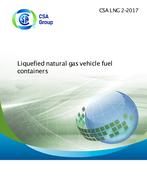CSA LNG 2-2017
Click here to purchase
Preface
This is the first edition of CSA LNG 2, Liquefied natural gas vehicle containers.
Scope
1.1 General
This Standard contains performance requirements for the material, design, marking, and testing of serially produced, refillable containers intended only for the storage of liquefied natural gas for medium- and heavy-duty vehicle operation.
1.2 Construction or materials
All specifications as to construction or materials may be satisfied by any construction or materials that will provide at least the equivalent level of performance set forth herein. The current technology for LNG tanks consists of a double walled vessel built of austenitic stainless steel, where the inner vessel holds the LNG and the outer vessel provides insulation and protection from the environment. Additional tests may be required to evaluate potential failure modes that pertain to the new construction or materials that are not specifically addressed in this Standard.
1.3 Units of measure
This Standards contains yard/pound quantities corresponding to the SI (metric) units, the purpose being to allow the Standard to be used in yard/pound quantities. IEEE/ASTM SI 10, American National Standard for Metric Practice, or ISO 80000-1:2009 Quantities and units %u2014 Part 1: General, is used as a guide in making metric conversion from yard/pound quantities.) If a value for a measurement and a corresponding value in other units are stated, the first stated value is to be regarded as the requirement. The given corresponding value may be approximate. If a value for a measurement and a corresponding value in other units, are both specified as a quoted marking requirement, the first stated unit, or both are to be provided.
1.4 Gauge pressure
All references to “psi” throughout this Standard are to be considered gauge pressures, unless otherwise specified.
1.5 Terminology
In this Standard, “shall” is used to express a requirement, i.e., a provision that the user shall satisfy in order to comply with the standard; “should” is used to express a recommendation or that which is advised but not required; and “may” is used to express an option or that which is permissible within the limits of the Standard.
Notes accompanying clauses do not include requirements or alternative requirements; the purpose of a note accompanying a clause is to separate from the text explanatory or informative material.
Notes to tables and figures are considered part of the table or figure and may be written as requirements.
Annexes are designated normative (mandatory) or informative (non-mandatory) to define their application.
Product Details
- Edition:
- 1st
- Published:
- 03/01/2017
- ISBN(s):
- 9781488306167
- ANSI:
- ANSI Approved
- Number of Pages:
- 31
- File Size:
- 1 file , 1.4 MB
- Product Code(s):
- 2424740, 2424740, 2424740
